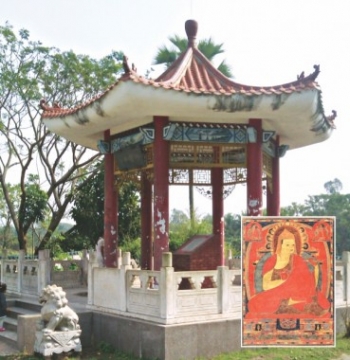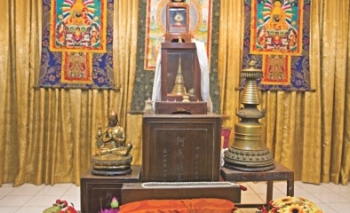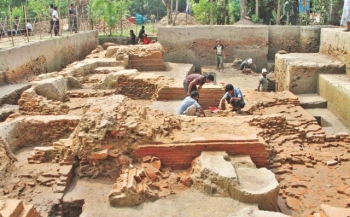 Atish Dipankar- Mausoleum at Vajrayogini. Photo by Dipta Saha. From thedailystar.net
Atish Dipankar- Mausoleum at Vajrayogini. Photo by Dipta Saha. From thedailystar.net Atish Dipankar's ashes preserved at Dharmarajika Buddhist Temple in Dhaka. Photo by Sazzad Ibne Sayed. From thedailystar.net
Atish Dipankar's ashes preserved at Dharmarajika Buddhist Temple in Dhaka. Photo by Sazzad Ibne Sayed. From thedailystar.net Temple remains. Photo by Palash Khan. From thedailystar.net
Temple remains. Photo by Palash Khan. From thedailystar.netAtish Dipankar (Skt. Atisha Dipamkara; 980–1053) was a widely known Buddhist master, scholar, and philosopher. He was born in Vajrayogini Village in the historic region of Vikrampur, in the present-day Munshiganj District of Bangladesh. Due to his remarkable contribution to Buddhism in the Tibetan region, he is highly venerated and respected throughout Asia, and especially in Tibet. Illness and the unfavorable weather conditions of the Himalayan region having prevented him from returning home to Bangladesh, he died in Tibet at the age of 73, and due to political changes and Muslim rule in Bengal until the middle of the 18th century, was until quite recently forgotten in the land of his birthplace as well as on the Indian subcontinent. The majority of his ashes and some personal belongings are preserved at Nyetang in Tibet to this day.
In the late 19th century, a scholar and diplomat from Chittagong in East Bengal (present-day Bangladesh), Sharat Chandra Das (1849–1917), went to Tibet as a representative of the British Empire. While there, he visited remote Tibetan monasteries and ancient Buddhist sites, and read a number of ancient manuscripts. Based on his experiences he wrote two books: Indian pandits in the Land of Snow (1893) and Journey to Lhasa and Central Tibet (1902). From these, the Bengali people learned about Atish’s birthplace and achievements for the first time.
Named Chandragarbha by his parents, Atish was born in 980 to a royal family in Bengal. His father was called Kalyanasri, and his mother, Prabhabati. From a young age, he displayed a great interest in knowledge and the wisdom of the Dharma, and at the age of 19, was ordained as a novice monk and given the name Dipankar Srigyan. He studied under Jetari, a great master of the time, and excelled in astrology, logic, philosophy, Sanskrit, and the sciences. At 29, he took full monastic ordination under Acharya Shilarakshita (the chancellor and an eminent scholar at Odantapuri Mahavihara in Magadha, the second oldest university in ancient India), and because of his outstanding knowledge and wisdom was named Atish Dipankar Srigyan, meaning “glorious wisdom source of light.”
Atish went to Buddhist universities both in the region and overseas, and became renowned as the greatest Buddhist scholar of the time. In 1024, King Mahipala I (r. c. 988–1038) of the Pala dynasty made him chancellor of the Buddhist university Vikramshila, in Bhagalpur District in today’s Bihar State. From there he went to Tibet, where Buddhism was in decline, at the invitation of the Tibetan king, arriving there in 1042. Atish would spend the rest of his life in Tibet, translating, writing, and compiling Buddhists texts. While some of his writings have been preserved there, his earlier writings in Sanskrit and Bengali are unfortunately no longer in existence.
After Atish Dipankar was rediscovered in his motherland nearly a thousand years after his birth, some of his ashes were offered to Bangladesh by China. In June 1978, a six-member delegation headed by Mr. Asafoddowla, director general of the Bangladesh Shilpakala Academy (the principal state-sponsored national cultural center of Bangladesh), went to China to receive them. On 16 June, following a ceremony, the ashes were given to Venerable Vishuddhananda Mahathera, representing the Buddhist community of Bangladesh. Venerable Chao Puchow of China stated that through the transmission of the great master's ashes, the traditional bonds of friendship between the two countries had been strengthened. Today, the donated ashes are kept at Dharmarajika Buddhist Temple in Dhaka, the capital city of Bangladesh.
Since then, Atish has become a symbol of China-Bangladesh relations. A mausoleum has also been constructed in his memory in the village of his birth by the people of China, with support from the Bangladeshi government and the Bangladesh Bauddha Kristi Prachar Sangha.
Although historians claimed that Atish was born in Vikrampur, there had previously been no archaeological evidence to prove it. However, recent research and excavations by archaeologists from Bangladesh would seem to indicate that Atish was indeed from this area. Financed by the Ministry of Cultural Affairs of Bangladesh, in 2010 the local organization Agrasar Bikrampur Foundation and the Archaeology Department of Jahangirnagar University jointly began to excavate a site in Nateshwar, Munshiganj. On 13 April 2012, archaeologists announced the discovery of a 2.5-meter-wide wall around three feet below the surface, which was thought to belong to a Buddhist temple; this was confirmed on 23 March 2013. They also unearthed around 100 Buddhist statues, sculptures, and copper plates, and declared the site to be around 1,000 years old. The research director of the project, Professor Sufi Mustafizur Rahman, told The Daily Star, “This is an incident of huge importance to all of us. Many historians have mentioned about a Vihar at Bajrojogini in Bikrampur, but we are lucky to find it just within three years.”
This year, Agrasar Bikrampur Foundation and Jahangirnagar University began a collaboration with the Hunan Provincial Institute of Archaeology of China. On 16 February, the joint team announced that they had discovered the remaining parts of the temple, including octagonal arm angle piles, internal octagonal piles, chambers, and porches. Based on the archaeological evidence, researchers have now confirmed this to be Atish Dipankar’s birthplace. The country’s first site museum is now being set up at the excavation site, where examples of artifacts and relics found at the dig will be placed on display.
Not only has Bangladesh now discovered Atish Dipankar’s birthplace, but in recent years, many institutes have also been set up to commemorate him. For example, the Atish Dipankar University of Science and Technology was established to honor the great scholar in 2004. One of its aims is to be recognized as a center of excellence in South Asia by imparting a high standard of education following international methods of teaching and research. Another organization founded in the memory of Atish is The Atish Dipankar Gobeshana Parishad (The Atish Dipankar Research Centre). Every year they award the Atish Dipankar Gold Medal to those making great contributions in different sectors of society. Likewise, the Bangladesh Bauddha Kristi Prachar Sangha offers the Atish Dipankar Peace Gold Award each year for outstanding contributions to religion and peace. In Dhaka, a road has been named after Atish Dipankar as well.
These activities by the Bangladeshi nation convey the strong message that Atish Dipankar’s memory is alive not only among his devotees in the rest of Asia, but also among his native people.
For more information, see:

















